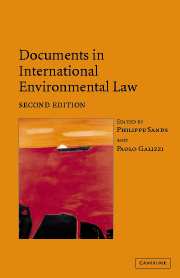Book contents
- Frontmatter
- Contents
- Preface
- PART I General instruments
- PART II Atmosphere
- 5 Convention on Long-Range Transboundary Air Pollution, 13 November 1979
- 5A Protocol to the 1979 Convention on Long-Range Transboundary Air Pollution on Further Reduction of Sulphur Emissions, 14 June 1994
- 5B Non-Compliance Procedure
- 6 Convention for the Protection of the Ozone Layer, 22 March 1985
- 6A Montreal Protocol on Substances that Deplete the Ozone Layer, 16 September 1987
- 6B Non-Compliance Procedure
- 7 United Nations Framework Convention on Climate Change, 9 May 1992
- 7A Kyoto Protocol to the United Nations Framework Convention on Climate Change, 11 December 1997
- 7B Marrakech Accords (extracts)
- PART III Oceans: global
- PART IIIB Oceans: regional
- PART IV Freshwater resources
- PART V Biodiversity
- PART VIA Hazardous substances and activities: nuclear
- PART VIB Hazardous substances and activities: pesticides
- PART VIC Hazardous substances and activities: waste
- PART VII Human rights and the environment
- PART VIII War and the environment
- PART IX Trade and the environment
- PART X Environmental impact assessment and access to information
- PART XI Liability for environmental damage and breaches of environmental obligations
- PART XII The Antarctic
5 - Convention on Long-Range Transboundary Air Pollution, 13 November 1979
Published online by Cambridge University Press: 05 June 2012
- Frontmatter
- Contents
- Preface
- PART I General instruments
- PART II Atmosphere
- 5 Convention on Long-Range Transboundary Air Pollution, 13 November 1979
- 5A Protocol to the 1979 Convention on Long-Range Transboundary Air Pollution on Further Reduction of Sulphur Emissions, 14 June 1994
- 5B Non-Compliance Procedure
- 6 Convention for the Protection of the Ozone Layer, 22 March 1985
- 6A Montreal Protocol on Substances that Deplete the Ozone Layer, 16 September 1987
- 6B Non-Compliance Procedure
- 7 United Nations Framework Convention on Climate Change, 9 May 1992
- 7A Kyoto Protocol to the United Nations Framework Convention on Climate Change, 11 December 1997
- 7B Marrakech Accords (extracts)
- PART III Oceans: global
- PART IIIB Oceans: regional
- PART IV Freshwater resources
- PART V Biodiversity
- PART VIA Hazardous substances and activities: nuclear
- PART VIB Hazardous substances and activities: pesticides
- PART VIC Hazardous substances and activities: waste
- PART VII Human rights and the environment
- PART VIII War and the environment
- PART IX Trade and the environment
- PART X Environmental impact assessment and access to information
- PART XI Liability for environmental damage and breaches of environmental obligations
- PART XII The Antarctic
Summary
Editorial note
The Geneva Convention was negotiated within the UN Economic Commission for Europe on the initiative of Scandinavian countries which had long been concerned about the problem of acid precipitation. The definition of ‘air pollution’ in Article 1(a) is clearly wide enough to bring many substances within the scope of the Convention. This was the first multilateral Convention relating to the protection of the environment which involved almost all nations of Eastern and Western Europe, and its parties included the USA and the then USSR. It was also the first to deal specifically with the problem of long-range transboundary air pollution where it is not possible to distinguish the contribution of individual emission sources (Article 1(b)). The politically varied and regionally comprehensive adherence to the Convention might be a result of the ‘soft’ nature of the obligations it establishes. In particular it is clear from a solitary footnote that the question of State liability for damage fromtransboundary air pollution is beyond its scope. Article 2, which sets out the general obligation to limit, reduce and prevent air pollution, is hedged with qualifications. The ‘best available technology’ requirement in Article 6 is limited to that which is ‘economically feasible’.
The Convention obliges States to exchange information, consult and undertake research. Article 8 sets out in detail the type of information to be exchanged.
- Type
- Chapter
- Information
- Documents in International Environmental Law , pp. 33 - 43Publisher: Cambridge University PressPrint publication year: 2004



